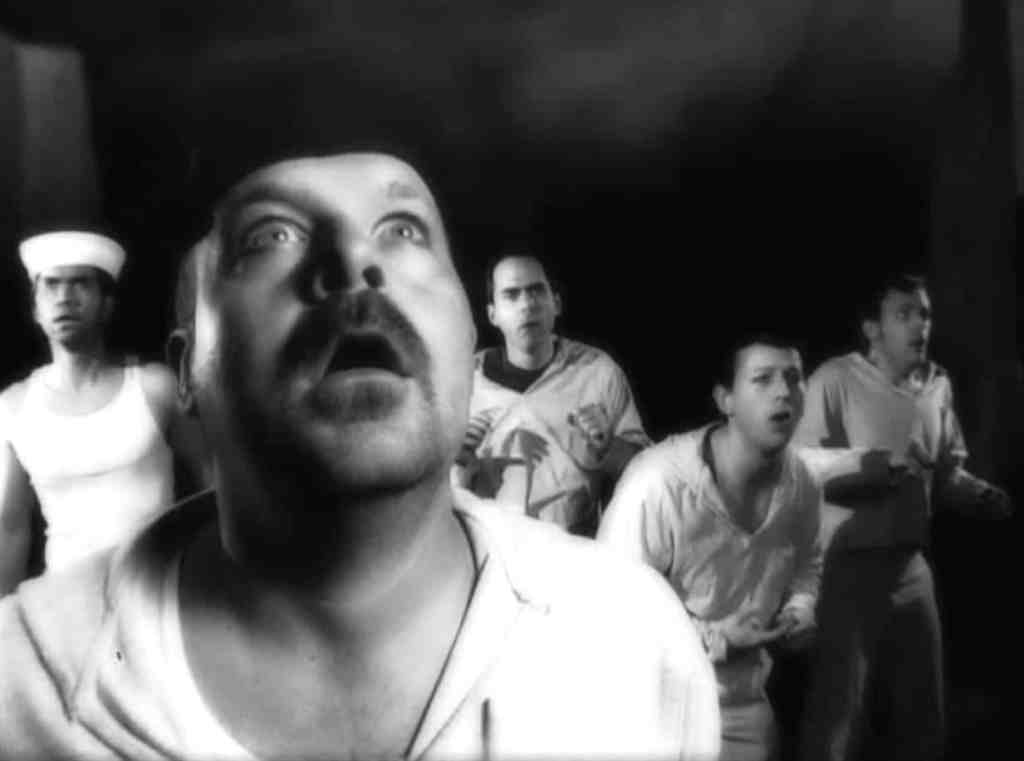★★★★★ out of ★★★★★
A silent, black & white labor of love. Iä! Iä! Cthulhu fhtagn!

Cthulhu Rises in The Call of Cthulhu (2006) 
Doomed sailors in The Call of Cthulhu (2006)
The year was 2005. Movies were in their infancy and we’d still be waiting quite a while before filmmakers could give us “talkies”, let alone movies in color… At least, I think that’s right. In any case, from out of the chaos of those nascent days arose a shining example of how to make a fun movie for about a buck twenty-five.
Producer/director Andrew Leman’s The Call of Cthulhu is said to be the first film adaptation of one of H.P. Lovecraft’s most famous stories. And with the H. P. Lovecraft Historical Society acting as a distributor for the film, rest assured that this adaptation stays true to the original story. Nearly scene by scene is a perfect match, in fact. That level of attention to detail only comes from true fans of the source material. Especially when you’re working with less than a shoestring budget.
Why black & white and silent? Leman and his production partner, Sean Branney, decided early on that they wanted to create something that looked like it could have been made in 1926. It also helps that shooting in black and white is more forgiving than shooting in color when you’re on a tight budget and can’t afford to worry about things like the specific materials you’re using in your sets and costumes. That bold decision made, Sean Branney set about adapting the original short story to fit a cinematic format.
For anyone not familiar with the story, it’s a winding tale involving a dark cosmic mystery. Eons ago, old gods had ruled the universe. Cthulhu happened to be one of them. When their time had come to an end, the old gods returned to wherever it was they came from and Cthulhu took a nap at the bottom of the sea. On his own, sunken private island no less! There he waits — as do the other old gods — for a time “when the stars are right” and they can make their return to reclaim what was once theirs. Namely, everything. And they don’t plan on being nice about it either.
The movie — or, rather, featurette, since The Call of Cthulhu‘s run time clocks in at about 47 minutes — depicts the tale as it’s being told by a mental patient (Matt Foyer). He does this through the surprisingly coherent use of flashbacks within flashbacks. At one point, the movie goes at least four flashbacks deep! Now that’s impressive. Don’t worry, though, you always make it back out. It’s a tale of nightmares and cultists and strange idols and shipwrecks. Of coincidences and revelations and forgotten mysteries.

Exploring R’lyeh in The Call of Cthulhu (2006)
True to form for a silent film, nearly everything rides on the score. Since nobody’s talking and there aren’t any sound effects, the film’s music is thrust to the forefront. Despite losing their composer late in the game to scheduling conflicts, the filmmakers were able to find the talent they needed to flesh out their completely original score. The music ties the scenes together wonderfully and acts as a sort of omnipresent character guiding viewers through the film.
Also, if you’re a fan of film techniques before computers took over, The Call of Cthulhu is a treat. Superimposition, tricks with perspective and angles, and “special effects” like a stormy sea made by waving blankets all make for a fun trip back into cinematic history. There’s even a big, stop-motion Cthulhu figure! That should make you want to see the movie all on its own.
What it all comes down to is that this movie was a labor of love by a group of people who truly enjoy the original stories. Sure, there’s over-acting, the sets often look like they’re about to tip over, and the special effects are mildly goofy at times, but if you can look past all that, you’ll find performances with heart, one of the truest book-to-screen adaptations I’ve ever seen, and it’ll be a fun 47 minutes watching a story that many thought “unfilmable” come to life.

